Fall 2024
-
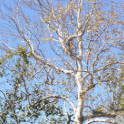
Invasive beetle known for killing trees spotted in the Bay Area
by Dorothy Abeyta
The headline above appeared recently in the SF Chronicle, on Facebook, X, and local news sources, but the Invasive Shot Hole Borers (ISHB) have been in the Bay Area since last year when they were spotted in north San Jose. The first beetle was detected in Los Angeles County in 2003 and the second beetle twin (for lack of a better term) was detected in San Diego County in 2014. They have spread north to San Luis Obispo County and east to Riverside and San Bernardino counties. The most recent find in Santa Clara County is a leap up the coast, which points out that the mode of spread appears to be artificial, i.e. spread by humans transporting infested firewood and green waste. This beetle is non-native and therefore, has no natural enemies to keep it in check. Preventing it’s spread is the number one method for control. The state has implemented “Buy It Where You Burn It” and “Don’t Move Firewood” campaigns directed at residents to make them aware this invasive insect IS a problem and urge them not to spread the problem.
-
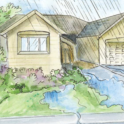
Planting the Rain: A Guide for Passive Rainwater Harvesting
by Lori Palmquist
Autumn has arrived, and we anticipate (actually, hope for) a healthy bounty of liquid refreshment from the sky this season and the next. We all know that fall is the best time to plant. It’s also the best time to start planting the rain.
I’d like to pose a question to you, my fellow Californian. Why do we insist on irrigating our landscapes with water collected in the Sierra, pumped through pipes for hundreds of miles, and then treated with chemicals to meet human drinking water standards? Does this seem even a little nonsensical to you? If that were the only water available to us, it would make perfect sense.
-
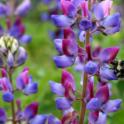
Plant Natives this Fall
by Robin Mitchell
Because California is a biodiversity hotspot, that is threatened by many factors, it is important to plant native plants in our gardens, even in urban and suburban areas. Planting 50%—75% native plants in our gardens creates a healthy native ecosystem in our community that supports (or maintains) our native insects, reptiles, amphibians, birds, and mammals. Healthy ecosystems are more resilient to changes in climate and can lessen the effects of climate change.
Planting California native plants in your gardens and encouraging others in your community to do the same is a powerful way each of us can contribute meaningfully to climate change solutions.
-
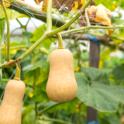
Growing Winter Veggies on Patios
by David George
There is a crispness in the air, which means that autumn is right around the corner. Fall also marks the time when the growing season comes to an end across most of the US. But not in Contra Costa! We are blessed with a mild winter climate that allows us to grow delicious, healthy table vegetables throughout the winter months. Do you grow fall and winter veggies in your patio containers? You should! Here’s how.
-
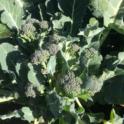
Prepping Vegetable Beds for Winter
by Greg Letts
So, you have harvested the last of your tomatoes and peppers for the year. Now what?
Let’s start with dispelling the myth that your veggie beds need to rest. Your vegetable beds don't need to rest during the off-season. In fact, it's much better for your soil to stay active. Keeping it active encourages earthworms to stay and allows the millions of beneficial microbes to continue their important work.
-
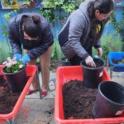
Introducing a New Contra Costa Master Gardener Project
by Anne Sutherland
In our big, vibrant county, Spanish is spoken in nearly 30% of households. As most of you know, English is typically spoken at our talks, Farmers Market tables, and in our videos... until now!
The word for gardeners in Spanish is jardineros (hardeenéros), which is the name of our new project. When reaching out to Spanish-speaking communities, we are finding rich, diverse groups of people of all ages who want to learn about the world of soil, plants, ecosystems, and how to grow their own food.
-
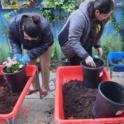
Presentamos un nuevo proyecto de Jardineros Maestros de Contra Costa
by Anne Sutherland
Varios de nosotros enseñamos clases prácticas y apoyamos jardines en programas escolares y comunitarios y en eventos especiales en todo el condado. Recientemente tuvimos un puesto en la Plaza Todos Santos en Concord para el Festival Latino, celebrando el Mes Hispano. Tuvimos más de 100 conversaciones, incluyendo con organizaciones de la comunidad que quieren colaborar con nosotros y futuros Jardineros Maestros bilingües.
-
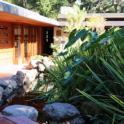
Understanding Defensible Space Zone 1: Your Key to Fire-Resistant Landscaping
by Hedwig Van Den Broeck
In this fall issue of News to Grow By, we’re diving deeper into creating fire-resistant landscaping for Defensible Space Zone 1, also known as the Lean, Clean, and Green Zone, which extends 5–30 feet from your home. This area is your first line of defense against wildfires, and understanding how to manage it effectively can make all the difference in protecting your home.
-
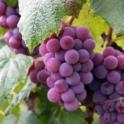
Wrapping up 2024 with a big Thank You to our Readers
We’d like to express our heartfelt gratitude for your continued interest in our program. Your passion for expanding your knowledge in horticulture, pest management, and sustainable landscaping practices inspires us every day.









